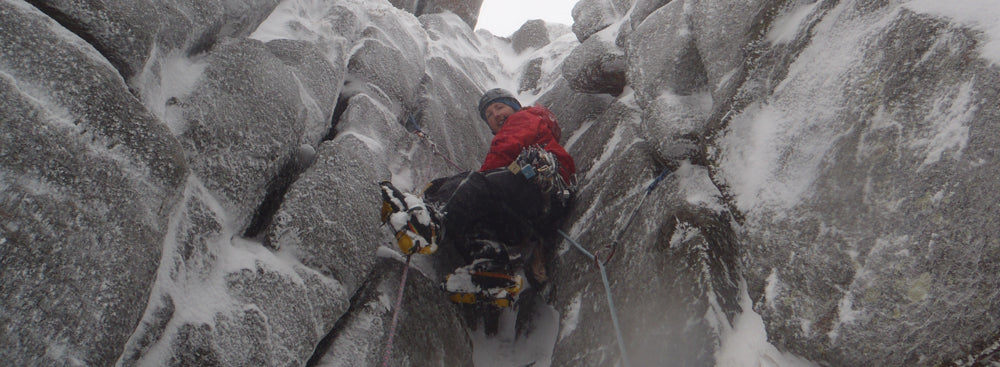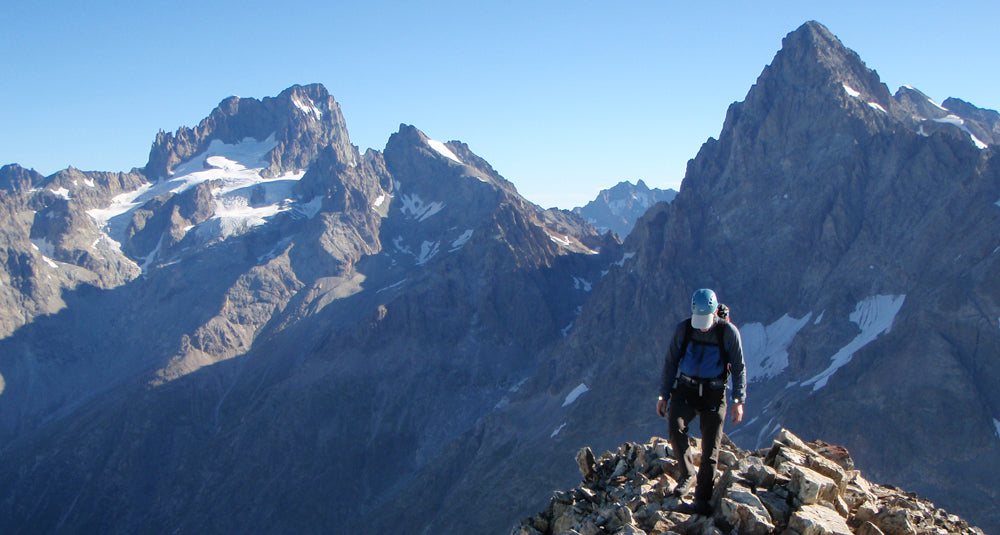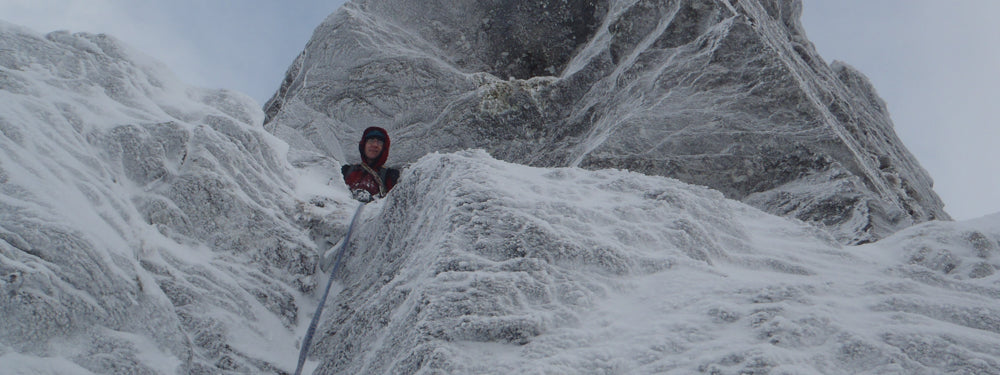
Euan Whittaker and the ClimbNow Team - Mountain Guides
Share
Euan, can you please tell us a little about yourself, and what you do?
I am a IFMGA Mountain Guide and Mountain Instructor who lives 5 months of the year in the French Alps and 7 months of the year in Scotland. I spend my time ice, mixed and rock climbing, climbing alpine peaks, ski touring and off piste skiing
Who introduced you to the outdoors?
At around about the same time I had two starts in the outdoors. The school I was at set up a rock climbing club and the Boys Brigade I was in introduced me to hill walking and camping. I was aged around 13.
When did you decide you wanted to be a guide? How long have you been a guide for?
When I was away with the school rock climbing at a venue in the North West Highlands of Scotland called Reiff, I knew I wanted to work on the crag and in the mountains. At that time I had never met an Alpine Guide or knew what one was but knew I wanted to be a Mountain Instructor. A couple of years later, I spotted an advert for British Mountain Guides in a climbing magazine. It explained that it was the highest qualification in the world and I knew then that it was what I wanted to do.

What is ClimbNow and what do you do?
ClimbNow is a guiding and instructional organisation that works throughout the UK, Europe and beyond. We aim to provide trips to the mountains that cater to the individual and cater for all abilities. We provide courses in winter climbing, rock climbing, skiing and alpine mountaineering.
It is run by three friends who all have a similar client and safety focused approach to guiding and instructing.
Who are the other guides you work with?
Paul is also an Alpine Guide. We have been best of friends since 2000 when we met on a Mountain Leader training course. He was an Usher at my wedding. Paul formally lived in Glasgow before Wales and is therefore known in Scotland as Glasgow Paul. This confuses many people who meet him now as he is actually Irish.
Martin is a Mountain Instructor. This is Martins second career as he was formally a Chemical Engineer. He is known for his love of new routing in Scotland, especially if the route involves vertical grass! Martin is also well known for still smiling even when he is very, very wet due to cold driving Scottish rain.

Paul - I see you have climbed in New Zealand. Our wool comes from New Zealand. What did you think of the climbing in New Zealand and any personal highlights? Did you see any merino sheep when you were out there?
I lived in New Zealand for all of 2005, based in Christchurch i had easy access to the southern Alps.
After climbing some of the famous peaks like Mount Cook and Aspiring I explored some of the lesser known valleys.
The highlight of this was a first ascent of Fortune favours the Bold TD 1300m a directissima on the south Face of mount McKerrow this was climbed with a local kiwi Steve Fortune and an ex-pat James Edwards.
A few great friends came out to visit including Euan and we had some excellent ski touring on the Tasman, Fox and Franz Joseph glaciers.
I did see some Merino sheep being sheared and noted the length of the wool strands.
Paul – You do a lot of guiding in the UK. What is the biggest challenge you face when you take clients out into the UK hills and mountains?
One of the biggest challenges in the UK hills is dealing with the weather and staying comfortable can be a challenge.
The clothing we wear allows Guides to go out in all conditions weather that is assessing Mountain Leaders in Snowdonia in November or working with British Mountain Guide trainees on Ben Nevis in January.
Martin – You have climbed all over the world, including in Yosemite. How was the experience?
Yosemite is visually stunning and the scale takes a little while to get used to. Once you’re up a few hundred metres above the valley floor the height begins to feel irrelevant. Oddly my strongest memory is a day spent retreating down El Capitan with snow melt pouring over us in waterfalls; a test of both your equipment and resolve.

Martin – Scottish winter climbing is quite different to climbing in the sunshine of Yosemite. Two questions. How would you describe Scottish winter climbing and second, how do you deal with the cold?
For me Scottish winter climbing is about accessible adventure. The size of the country, mountains and routes means that most climbs are accessible in a day from the main centres of population. However, the essence of adventure is that the outcome is uncertain: that is often the case in Scottish winter climbing due to conditions, weather and day length. Working with these constraints and using your experience to maximize your chances of a successful trip is a challenge I enjoy hugely.
Weirdly, given my love for Scottish winter climbing, I am a person who feels the cold. Food and clothing are the only real ways to deal with the cold. Food needs to be energy dense to minimize weight on climbs, but give your body the calories to keep warm. Clothing needs to be tried and tested for the individual, fit and work in the wide range of conditions we experience in Scottish winter. It has to work when it’s cold and dry, but also when it’s around freezing and soaking wet through as walk ins and outs in Scotland may take you through driving rain to get to and from your chosen winter line.
What is your favourite on the mountain meal/food?
Martin: My luxury food on the hill is an almond horseshoe from the local German baker. It’s basically marzipan with added nuts and chocolate. It’s full of energy, light, tastes great, doesn’t freeze in winter and fits in a pocket for when you need a quick snack.

What do your significant others think of you been away for long periods on expeditions?
Martin: I’m very lucky in that my partner Jen sees climbing trips as very much part of what makes me the person I am. She doesn’t look forward to me being away for long periods, but realizes I’d be miserable if I didn’t go.
Euan: My wife is very understanding. I have always been away for periods but do my best to keep these in balance with time at home and prioritizing family first.
Do they also climb and enjoy the outdoors?
Martin: My partner climbs a little, but doesn’t enjoy standing around belaying for extended periods, so together we walk and scramble more than climb. She enjoys being in the outdoors and particularly if it involves a journey, so over recent years we’ve been on sea kayaking, cross-country ski-ing and sailing trips.
Euan: Rosie has always enjoyed hill waling with friends. Since we started dating she has become a very good rock climber and excellent skier both on and off piste. She loves travelling and enjoys visiting climbing and skiing destinations around the world
How do you manage the work-life-family balance?
Martin: Doing a job where you are away a lot and working variable hours does mean you have to think about work-life-family balance. As a freelancer in any line of work it’s very tempting to take any work that is offered, however, setting aside days or blocks of days specifically to do things together as a family is really important.
Paul: The family work life balance is tricky I'm always torn between a drive to be in the mountains and the need to be a good Dad if anyone finds the perfect balance please let me know.
Euan: As a family we prioritize quality time together. This means that when I am home, we don’t sit around watching TV, but go out and enjoy each other’s company or if at home we sit and talk. We put quality time into our diaries to make sure it happens and I aim to have quiet periods throughout the year that we all spend together.

How do you manage the cold and dressing for the extreme conditions? Can you explain your layering ideas and how to manage the conditions?
Euan: My layering system varies depending on the environment and sport I am teaching or guiding. It does however have a few common threads;
- I always wear a good quality baselayer, underwear and socks. If these are not up to standard the rest of the layering system will not perform.
- I tend not to overheat but rather run cold. Therefore, on top I use pertex layers with synthetic fill and also polartec 100 fleeces. I find these dry faster than many other midlayers,
- In Scotland I use hard shells on top of these layers. In the Alps, I may carry a duvet jacket instead depending on the forecast and my itinerary.
It is essential to study the weather forecasts and current mountain conditions before deciding what to wear for any given activity.
Martin: I definitely use a layering system to manage cold and particularly the wet and cold conditions you can experience in Scotland. I think it’s important to tailor it to the individual and the conditions you’re going to experience. I’ve settled on the following as working well for me in most UK winter conditions:
- Merino base layer top, bottom and socks. I like a high neck top with a long zip for venting on the walk in or a merino neck gaiter if using a low neck top. This must be long enough in the arms and back as exposing areas such as wrists and lower back is asking to get cold.
- A snug fitting thin fleece top, preferably with a hood. This aids wicking of moisture away from my body, but allows ease of movement.
- On cold days snug fitting stretchy fleece bottoms. On warmer faster moving days I may do without these.
- A pertex layer or more often a micro fleece and pertex layer. This is often sufficient with a base layer whilst walking in to prevent overheating and provides an extra moisture barrier when worn under a hard shell in driving rain.
- Hard shell top and bottoms, which need to be snug fitting for climbing and with a hood which goes over a helmet.
- A hat or balaclava which fits under a helmet and gloves. Sometimes up to 4 pairs of gloves including mitts. Gloves get wet winter climbing in Scotland and a pair of mitts is always the warmest option if the weather turns really nasty.
- A belay jacket with some water resistance and probably a man made insulation fill for Scotland, although I am hearing some good things about the “waterproof” down fills now available.

Does baselayer make a difference?
Euan: A good baselayer is absolutely crucial. When working in an Alpine area such as the Monte Rosa Massif, it can be 30 degrees in the valley and -15 degrees on the tops. The baselayer has to be able to perform and be comfortable in both climates.
In the Scottish winter, we regularly overheat on the walk ins and then stand around in the cold. The baselayer must wick efficiently so as to dry quickly to prevent poor performance once the freezing level is met.
Paul: The Baselayer question is no longer an option it is just fact all Mountain Professionals wear some form of technical wicking baselayer it comes down to the shape/fit the quality and for some the fashion or colour or personal preference.
Martin: Absolutely, a good base layer makes a huge difference. It must fit including around neck, wrists, back and ankles. I will vary the weight of base layer I use dependent on the conditions and the activity I’m planning.

For an aspiring guide, what advice do you have for them?
Martin: Work with conditions rather than against them. Take time to get to know your clients and tailor days/trips as much as possible. Make sure you enjoy the type and style of work you do, as you’re going to spend a lot of time doing it.
Paul: Advice for aspiring guides.... enjoy the process of gaining prerequisites it should be just doing all the things you love.
Euan: Never be fixed on an idea or plan, always be willing to change and adapt. Seek out good mentors and advice. Always remember how important family and friends are.
Where can we find out more:





